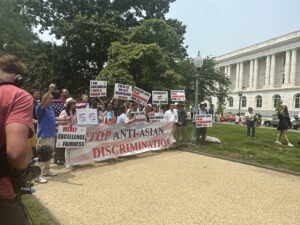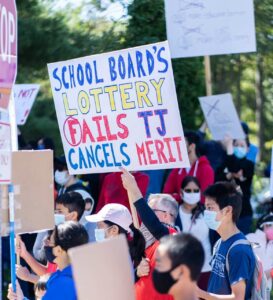Discourse: Segregation By Any Other Name

School segregation has risen from the grave—disguised under a different name.
An increasing number of school districts are offering “affinity classes” that cater to specific racial groups. Schools have long offered racially segregated options for electives such as African American history or mentorship programs. But the idea has begun to expand to the wider K-12 curriculum: One school district in Evanston, Illinois, has drawn the media’s eyes recently for expanding affinity course options, now offering segregated courses in the core curriculum, like math and English. Technically, anyone can join, but each class is expressly designed for—and targeted at—a particular racial group.
In reality, “affinity” is just a newfangled term for “segregation.” Schools that support such racial sorting insist these classes are opt-in, benign programs that don’t violate anti-discrimination laws or the Constitution’s equal protection guarantee. They’re wrong.
Eliminating Racial Discrimination… Or Preserving It?
The supporters of affinity groups and classes claim that they give students a comfortable, safe and inviting environment that improves learning outcomes. One Evanston school official who backs affinity classes told The Wall Street Journal that too often “Black students are expected to conform to a white standard” and that in affinity classes, “you don’t have to shed one ounce of yourself because everything about our space is rooted in Blackness.” The notion that culture and character are pinned to skin pigment undergirds the philosophy behind affinity programs—that races are so different from one another that they should not even learn together.
This idea parrots the very racists who sought to block integration in the late 1950s. Former Alabama Gov. George Wallace, who once thrust himself into a school doorway to block Black students, argued that racial groups were better off teaching and learning within their own “separate racial stations,” otherwise society would merge into one “mongrel unit” that would impede the development of each separate race.
But the frenzied agitprop of the 1957 bigot has now become the callow mantra of the 2024 “anti-racist.” The big difference between now and then, argue the pro-segregationists of our age, is that affinity classes are voluntary. Students of color can remain integrated if they wish to do so, although the schools relentlessly laud the benefits of segregating. Granted, there is a difference between compelling someone to drink poison and simply encouraging them to drink it. But this ignores the obvious choice—tossing out the poison. As Chief Justice John Roberts said in the Supreme Court’s recent affirmative action decision in Students for Fair Admissions v. Harvard, “[e]liminating racial discrimination means eliminating all of it.”
And discrimination, whether we call it affinity or segregation, is poison to a multicultural society. Affinity programs set students up for failure when they exit their racial cloisters into a multiracial world—a world that the school has taught minority students to fear as a forbidding place where people do not understand or care about them.
Ironically, the progressives’ rationale for affirmative action in secondary education—to diversify student bodies so students learn to work across culture gaps—is antithetical to the modern segregationists. What are we telling K-12 students when schools teach them that they are better off separating from other races? The natural takeaway is that racial harmony is a myth and that race is more than skin deep—that it divides us forever.
Thus, the sloppy reasoning behind affinity classes—that people are better off among members of their own race—does not stop at schools. Carried to its logical conclusion, such thinking would mean intentionally segregated churches, workplaces, neighborhoods and so on. Sound familiar? We know from some of the greatest tragedies in human history where this thinking leads us.
Legal Underpinnings
But affinity classes are more than a bad idea: They’re also illegal. Schools think they can comply with the law if the classes are voluntary and technically open to everyone. But they’re wrong for at least two reasons.
First, affinity classes do not benefit all races equally and are thus discriminating based on race, even in the absence of compulsion. I know of no affinity offerings for white students specifically, and a school that created a white affinity course option would (rightly) spark a social media storm of outrageous proportions. To be clear, I do not favor a white affinity group—I favor canning the whole benighted idea. And there are many other racial and ethnic groups for which the Evanston school district offers no affinity courses—there is no Indonesian affinity group, no North African affinity group, no Chinese affinity group, etc. The school district’s banal view of diversity undermines its alleged commitment to inclusivity.
And while affinity proponents say that students of any race can technically join any affinity groups, that does not change the reality that the affinity courses focus on some racial groups to the exclusion of others. Surely, a student in an affinity group that targets a different race does not receive what the schools tout to be the greatest benefit of these classes—learning with and from people of your own race. Thus, the intended educational benefits of these affinity classes are offered to some races, but not others.
Schools will insist that all these classes are on equal footing, i.e., that they are separate, but equal. But differences are inevitable—smaller class sizes and different assignments, to name just two. Affinity classes also require additional resources earmarked for some races and not others. Plus, it is not enough to make segregated classes formally equal: The Supreme Court in Brown v. Board of Education long ago proclaimed the truth that “[s]eparate educational facilities are inherently unequal.”
The second reason why affinity classes are unlawful is more theoretical but just as important. The Constitution’s equal protection promise creates a separation of race and state, much like the First Amendment’s establishment clause, which forbids the government from establishing a state religion. Both constitutional principles prevent the government from favoring or disfavoring certain groups over others—whether they be religious or racial—even if such favoritism does not necessarily coerce or penalize anyone.
We would all rightly oppose a public school that encouraged and helped students to divide themselves into cohorts based on religion—math for Catholics, science for Protestants, history for Muslims. Such divisions would serve the same purported goals as racial affinity groups: They would allow students to learn with and from people that they easily bond with. But all of us, I hope, would see the obvious tradeoff here: While such divisions might help students identify with their classmates, they would strangle the tolerance and goodwill among diverse groups that are key to a healthy society. The same principle applies to race. As the dissenting justice in Plessy v. Ferguson said, “Our constitution is color-blind, and neither knows nor tolerates classes among citizens.”
Racial sorting, even when voluntary, is especially harmful to children. Consider another religion example: In Lee v. Weisman, the Supreme Court said a public school had violated the First Amendment’s establishment clause by allowing a clergyman to offer a nonsectarian prayer at a school graduation ceremony, which favored no particular religion. The school argued that the prayer did not compel anyone to do anything—objectors could decline to attend or stay seated when invited to stand for the prayer.
The Supreme Court held that it nonetheless violated the Constitution: The prayer “bore the imprint of the State and thus put school-age children who objected in an untenable position.” The situation would place “subtle coercive pressure” on impressionable children, which “can be as real as any overt compulsion.”
This reasoning applies to affinity groups as well. The government’s racial sorting, and the implied import and value of racial sorting, bears “the imprint of the State” and imposes coercive pressure on students to divide themselves by race. Lee v. Weisman’s focus on the psychological impact on the students has a striking parallel in Brown: “To separate them from others of similar age and qualifications solely because of their race generates a feeling of inferiority as to their status in the community that may affect their hearts and minds in a way unlikely ever to be undone.”
Students of all races deserve a good education. But the answer is not to encourage students to separate themselves by race. Every student deserves the challenges and opportunities that face anyone who lives in a diverse society brimming with people who do not see the world as they do. And they deserve a school that stays out of the sordid business of segregation—whatever it may be disguised as today.
This op-ed was originally published in Discourse on February 1, 2024.







